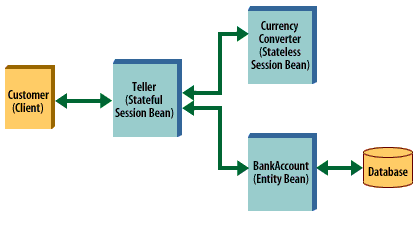| Lesson 6 | Entity Bean Course project |
| Objective | Develop a realistic EJB Application |
Entity Bean Course Project
The course project is to develop a simple banking application.
You will create the appropriate beans for the business objects (BankAccount) and the business processes (Teller, Currency Converter), plus a Customer client. In the first course in this series you developed the BankCustomer, BankAccount, and CurrConv enterprise javabeans. In this part you will convert the BankAccount bean to an Entity Bean.
To verify transactions can be applied to EJBs, you will be creating a Teller bean that transfers a sum from one bank account to another under the umbrella of a transaction. This application is pretty realistic as it requires an appropriate set of intercommunicating EJBs with similar functionality to those that would be required in real-world EJB development. The final solution will look like the schematic below.
You will create the appropriate beans for the business objects (BankAccount) and the business processes (Teller, Currency Converter), plus a Customer client. In the first course in this series you developed the BankCustomer, BankAccount, and CurrConv enterprise javabeans. In this part you will convert the BankAccount bean to an Entity Bean.
To verify transactions can be applied to EJBs, you will be creating a Teller bean that transfers a sum from one bank account to another under the umbrella of a transaction. This application is pretty realistic as it requires an appropriate set of intercommunicating EJBs with similar functionality to those that would be required in real-world EJB development. The final solution will look like the schematic below.

At the end of most modules, you will be asked to complete a specific project exercise that verifies and reinforces the information you learned in that module. The project exercises build one upon the other. To save you typing in all the code required, I have provided skeletons for you to download and edit where necessary. You will find a "???" in the code wherever you have to make a decision and add something.
There will be a clear comment associated with each entry that you need to make. The information required will be in that or previous modules.
There will be a clear comment associated with each entry that you need to make. The information required will be in that or previous modules.
For example:
/* In order for a CalculatorBean to be a Stateless Session Bean it will be a class */ public class CalculatorBean extends MathBean{ // code body }
EJBs appear simple until you have to program them. You will get much more from this course if you try it out before looking at the solutions.